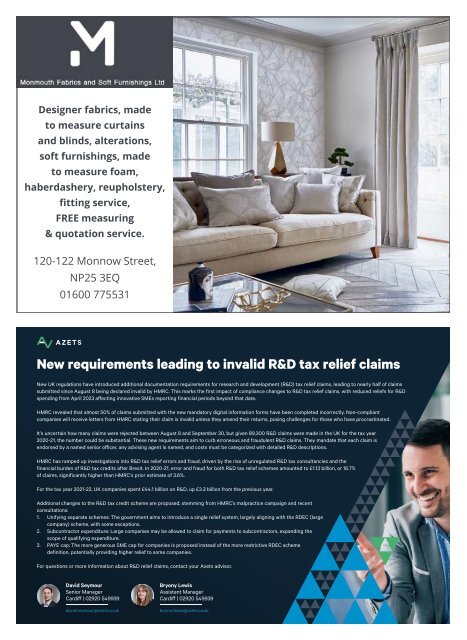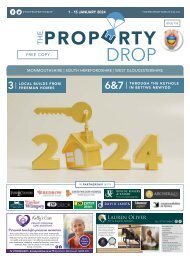You also want an ePaper? Increase the reach of your titles
YUMPU automatically turns print PDFs into web optimized ePapers that Google loves.
Designer fabrics, made<br />
to measure curtains<br />
and blinds, alterations,<br />
soft furnishings, made<br />
to measure foam,<br />
haberdashery, reupholstery,<br />
fitting service,<br />
FREE measuring<br />
& quotation service.<br />
120-122 Monnow Street,<br />
NP25 3EQ<br />
01600 775531<br />
New requirements leading to invalid R&D tax relief claims<br />
New UK regulations have introduced additional documentation requirements for research and development (R&D) tax relief claims, leading to nearly half of claims<br />
submitted since August 8 being declared invalid by HMRC. This marks the first impact of compliance changes to R&D tax relief claims, with reduced reliefs for R&D<br />
spending from April 2023 affecting innovative SMEs reporting financial periods beyond that date.<br />
HMRC revealed that almost 50% of claims submitted with the new mandatory digital information forms have been completed incorrectly. Non-compliant<br />
companies will receive letters from HMRC stating their claim is invalid unless they amend their returns, posing challenges for those who have procrastinated.<br />
It’s uncertain how many claims were rejected between August 8 and September 30, but given 89,300 R&D claims were made in the UK for the tax year<br />
2020-21, the number could be substantial. These new requirements aim to curb erroneous and fraudulent R&D claims. They mandate that each claim is<br />
endorsed by a named senior officer, any advising agent is named, and costs must be categorized with detailed R&D descriptions.<br />
HMRC has ramped up investigations into R&D tax relief errors and fraud, driven by the rise of unregulated R&D tax consultancies and the<br />
financial burden of R&D tax credits after Brexit. In 2020-21, error and fraud for both R&D tax relief schemes amounted to £1.13 billion, or 16.7%<br />
of claims, significantly higher than HMRC’s prior estimate of 3.6%.<br />
For the tax year 2021-22, UK companies spent £44.1 billion on R&D, up £3.3 billion from the previous year.<br />
Additional changes to the R&D tax credit scheme are proposed, stemming from HMRC’s malpractice campaign and recent<br />
consultations:<br />
1. Unifying separate schemes: The government aims to introduce a single relief system, largely aligning with the RDEC (large<br />
company) scheme, with some exceptions.<br />
2. Subcontractor expenditure: Large companies may be allowed to claim for payments to subcontractors, expanding the<br />
scope of qualifying expenditure.<br />
3. PAYE cap: The more generous SME cap for companies is proposed instead of the more restrictive RDEC scheme<br />
definition, potentially providing higher relief to some companies.<br />
For questions or more information about R&D relief claims, contact your Azets advisor.<br />
David Seymour<br />
Senior Manager<br />
Cardiff | 02920 549939<br />
david.seymour@azets.co.uk<br />
Bryony Lewis<br />
Assistant Manager<br />
Cardiff | 02920 549939<br />
bryony.lewis@azets.co.uk

















